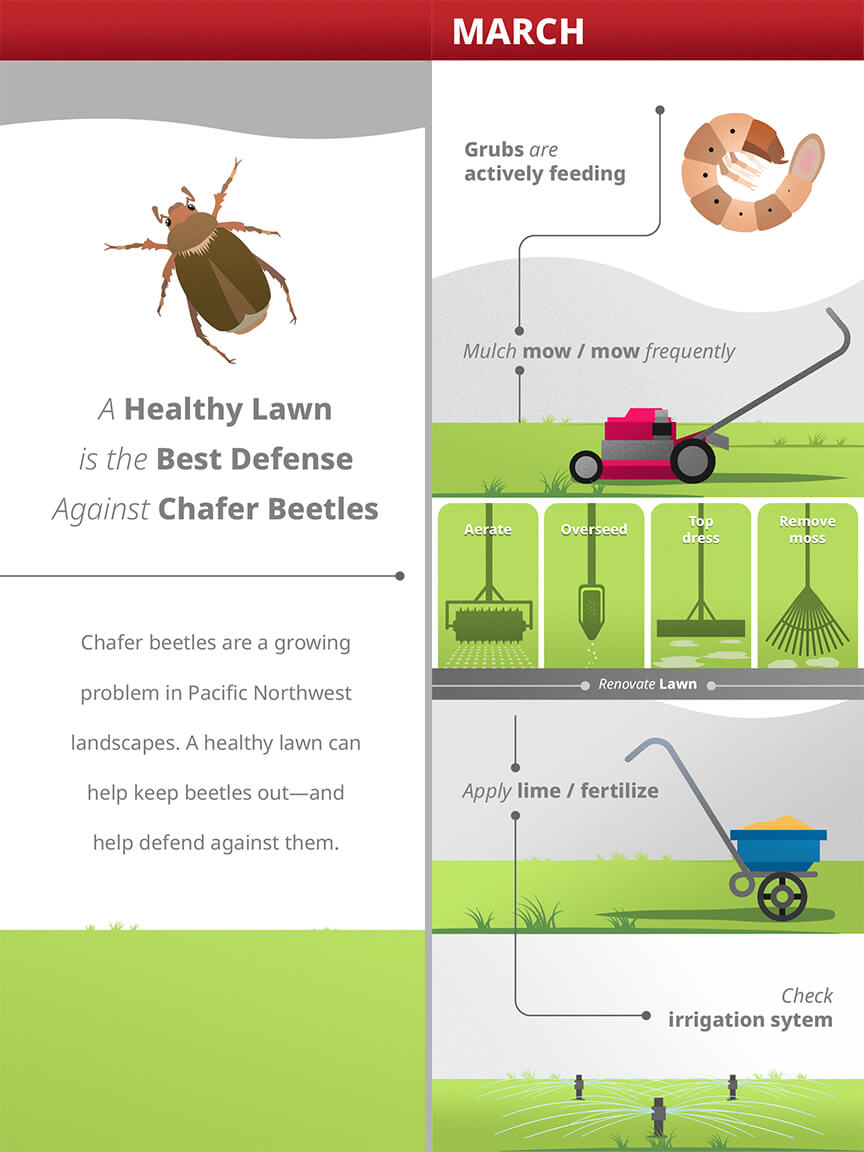The chafer beetle invasion
The European chafer beetle is a serious lawn pest that is spreading and causing lots of problems throughout the Seattle area. The beetle was first spotted in Washington in 2008.
“It’s just been exploding since we first found it,” Todd Murray, director of Washington State University’s Puyallup Research and Extension Center, told The Seattle Times. So far, the heaviest concentrations are in the South End. This includes Rainier Valley, South Park and West Seattle. SeaTac, Burien, Renton and surrounding communities also have thriving populations.
Why should I care?
The chafer “could pose the biggest threat in nearly half a century to turf grass lawns and athletic fields in the Pacific Northwest,” according to The Seattle Times. For most of the year, chafer beetle grubs, or larvae, live underground and feed on lawn roots.
Many birds and other animals find the grubs to be a tasty treat. People describe lawns that crows have ripped to shreds while looking for beetle larvae. Other animals feeding on the beetles include raccoons, skunks, sea otters and even bears.
Chafer beetles appear to be more of a problem on lawns that are dry, thin and unhealthy. Here are some tips on how to keep your lawn healthy, which should help prevent chafer beetles from invading your lawn. If beetles do invade, these same steps can help deal with the resulting damage.
What you can do
In March, the larvae or grubs in the soil are rising toward the surface. They are actively feeding on lawn roots. To help manage chafer beetles, take steps now to renovate your lawn and improve its health. And keep doing everything you can to keep your lawn healthy.
Mowing
- Mulch mow. When you leave clippings on the lawn, you add organic matter and nutrients. You can mulch mow with a regular mower and leave clippings on the surface to break down. Or use a mulching mower. It blows chopped clippings down to the soil, leaving a clean lawn.
- Mow frequently. If you mow every four to five days instead of every seven days, mowing time can be reduced up to 38 percent when you don’t bag your clippings.
- Increase mowing height to 2-1/2 to 3 inches. This produces deeper roots, shades out weeds and holds up better to damage. Cutting the grass short will allow moss and weeds in, prevent good root growth and be less resistant to erosion and compaction.
Aeration, overseeding and topdressing
- Aerate the lawn to improve its health. Mechanical aeration removes small cores two to three inches deep into the soil. Aeration has numerous benefits. It reduces soil compaction, improves oxygen content and stimulates root growth. It also improves the uptake of water and fertilizer and reduces water runoff and puddling.
- Overseed to fill in thin spots. We generally overseed after aerating. Overseeding thickens the lawn, so weeds and moss have a difficult time getting established.
- Topdress with a thin layer of compost and sand to protect the seed and build up the soil.
We offer aeration, overseeding and topdressing as part of our natural lawn care services.
Moss control
- Treat moss with iron. The Pacific Northwest has ideal conditions for moss, and the moss is thicker this year than normal. Now is a good time to control moss. We use iron (ferrous sulphate) to treat moss. It will dehydrate moss but will not kill it.
- Remove the moss with a thatching rake once it shrivels up and turns black. If it is not removed, it will continue to spread and grow more thickly. Take vigorously to loosen the moss and remove it from the lawn.
- Aerate, overseed and topdress following moss removal to fill in bare spots.
We offer moss control as part of our natural lawn care services.
Lime and fertilizer
- Apply lime to improve the pH of the soil. Most Pacific Northwest soils are acidic, which does not promote healthy turf.
- Fertilize with organic slow-release fertilizer over the course of the growing season to help keep the turf green, thick and healthy.
We apply lime and fertilizer as part of our natural lawn care services.
Irrigation and watering
- Check your irrigation system to make sure it is watering the lawn evenly.
- Water once or twice a week throughout the growing season. Aim for about an inch of water per week.
We can check and adjust your irrigation system.


Trackbacks/Pingbacks